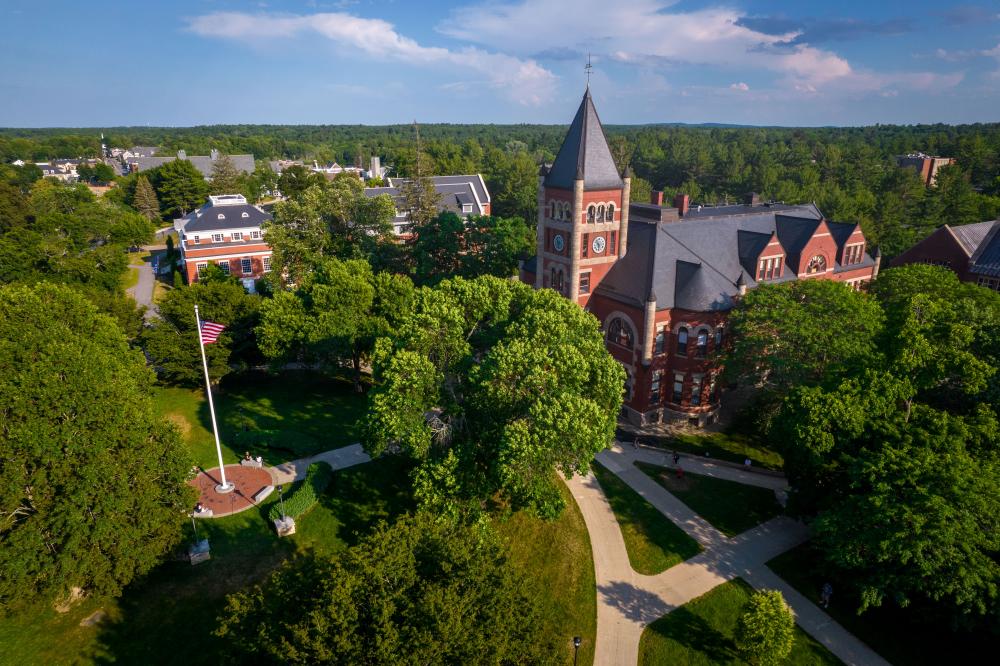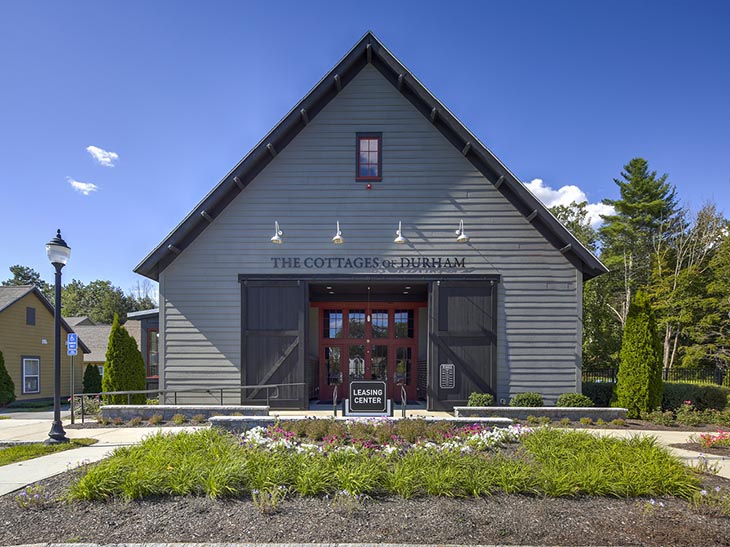 Aerial view of University of New Hampshire campus. (Courtesy of Scott Ripley/university of New Hampshire)
Aerial view of University of New Hampshire campus. (Courtesy of Scott Ripley/university of New Hampshire)
Development comes slowly to Durham, a small seacoast town that sits on the meandering banks of the Oyster River and to the west of the Great Bay. Its history is deeply intertwined with that of the state’s flagship university, creating a vibe where academia, entrepreneurial endeavors and scenic views converge.
Founded in 1866 as a land grant college, the University of NH (UNH) adopted its current name in 1923. Over the next century, UNH expanded its campus and programs, cementing Durham’s status as a college town. The community prospers from a highly educated workforce and federally funded research facilities, and benefits from its proximity to major roadways. Despite its easy accessibility to larger urban centers like Portsmouth, Durham retains its rural charm, boasting lush green landscapes and rolling hills. In fact, a significant portion of Durham’s terrain is dedicated to conservation land, providing ample opportunities for recreational activities.
No big manufacturing plants or company headquarters dominate this town of 15,000 residents, of which 6,000 are college students. UNH, the Oyster River School district and the town of Durham are the largest employers. Beyond these, a scattering of small businesses, restaurants and coffee shops dot the
commercial landscape.
“UNH is hugely important and integral to the town,” says Michael Behrendt, a 25-year resident and Durham’s planning director for the last decade. However, Durham is much more than UNH, he adds.
Nonetheless, many businesses benefit from UNH’s assets and talent.

Tideline Public House building with food truck. (Photo Courtesy of TideLine Public House.)
New Food Truck Haven
Behrendt is excited about three new projects in town. The first, Tideline Public, is a combination food truck court and indoor taproom and restaurant with outdoor seating, the first mobile eatery of its kind in the Seacoast.
What’s unusual about this foodie phenomena is that patrons can order from one of seven outdoor culinary concessions and take their meals indoors; likewise, diners from the indoor restaurant and taproom can choose to sit outside with their food. It’s a concept that succeeds as well on a frigid February day as a sunny August afternoon.
Owners Scott Letourneau and his wife Karen adopted a food truck business model they found appealing when they lived in Bend, Oregon. Originally from New England, the couple moved back east to Durham in 2020 and started scoping for locales close to home. The 15 Newmarket Road property across Route 108 and in the heart of the historic district seemed ideal, he says.
The town’s zoning ordinance encouraged repurposing and multiple use, he says. Another plus was that it is within walking distance of single-family homes and the university campus, offering a central location where people walking with strollers and dogs can share space with UNH students.
The Letourneaus closed on the property in June 2022. They rehabilitated two 19th-century houses that in various incarnations served as private homes, the town hall, the public works and police department, and more recently, an office building. They also transformed a salt storage shed from the 1920s into a heated gathering space with a rolled-up garage door.
Tideline Public opened for business in May and employs 32, many of whom are university students working part time.
 R.J. Kelly project at 121 Technology Drive (Courtesy R.J. Kelley Co.)
R.J. Kelly project at 121 Technology Drive (Courtesy R.J. Kelley Co.)
Building Revitalization Attracts Defense Manufacturer
Another project being celebrated by town officials is the revitalization of a fatigued 1980s office building by a real estate development company. Close to two years ago, the Burlington, MA-based R.J. Kelly Co. purchased the 500,000-square-foot office and manufacturing space at 121 Technology Drive. It currently houses the John Olson Manufacturing Center at UNH and Northeast Passage, a nonprofit that helps people with disabilities participate in sports and recreation.
CEO Brandon Kelly says we’re “taking a shell and transforming it into something else.” For starters, that includes new HVAC and electrical systems, loading areas, and windows, as well as upgraded bathrooms and parking lots.
This year, Kelly secured a major tenant, setting in motion bigger plans to fully redevelop the property. Having outgrown its Hampton location, Brazonics, which manufactures components for military and aerospace customers, is moving its 120 employees to this new facility by next year. The company, owned by Collins Aerospace, a subsidiary of Raytheon Technologies, signed a 15-year lease in anticipation of doubling its sales in five years and increasing its workforce by 25% in the upcoming year, according to General Manager Riaan Oosthuysen.
R.J. Kelly is refacing the exterior of 121 Technology Drive, creating an atrium of about 26,000 square feet furnished with high-top and low-tops tables, and couches. Other highlights include a gym and a cafe. Beyond the interior enhancements, R.J. Kelly will landscape the grounds for outdoor workspaces and recreational activities. With an expanse of 170 acres, Kelly says there is ample room for future development, potentially with housing.
Improvements to Route 4 and the Great Bay Bridge have made it easier to get to Durham from Interstate 95 and the west, which Kelly says is building momentum for companies relocating to NH from Massachusetts. Proximity to an academic institution is also an attraction.
Behrendt says the property always had potential but needed the right partner to develop it. “They [R.J. Kelly] have been assertive, creative and enterprising,” he says.
A Catalyst for Economic Growth
UNH is in the conceptual stages of redesigning a 50-acre parcel on Mast Road and Main Street near the town of Lee at the west edge of campus where administrative offices and bus parking are now located. The project, dubbed The Edge, aims to transform the lot into a mixed-use development with research labs, offices, retail spaces, dining, residential units for working professionals and other amenities.
Marian McCord, UNH senior vice provost for research, economic engagement and outreach, says the current buildings are outdated and disconnected from the rest of the campus. She says in the past, industry partners inquired about locating on campus, but the university had to turn them away. For example, UNH pursues research on ocean mapping and space science, and companies doing that type of work in NH would like to have labs adjacent to those owned by UNH.
“Our vision is to take that [the west edge] and transform it to a community where students, faculty, our industry
and government partners and staff can co-mingle and share ideas,” she says.
McCord anticipates the impact on the economy will be greater than the tax revenue and improved infrastructure for Durham. The Edge will encourage the formation of spin-off companies and startups commercializing the intellectual property generated by the university. Students will have the opportunity to work alongside businesses, and companies will have a first crack at talent. The concept, she says, is a breeding ground for innovation and invention. “It’s really a win-win,” she adds.
McCord says UNH will work with a real estate advisory group to consult on different options and financing. She anticipates seven to 10 years to fully establish the innovation neighborhood.
To bring the Edge to fruition, Behrendt says the town will work with UNH on current conventional zoning that limits creativity. In its place, the town will deploy a planned unit development (PUD) ordinance. Once that is established, the
ordinance will guide regulations for future developments.
Town and Gown Collaboration
UNH’s impact on the town is not confined to the physical boundaries of the campus; it extends into various parts of Durham. The two share resources, including water, power, cable, electricity and energy. They share a fire department, and the town and university police departments work closely together.
“There’s a lot of interdependence,” says UNH President James Dean, who meets regularly with the town administrator. A case in point was the response to COVID, he says. They coordinated policies so that students wouldn’t face a different set of guidelines as they walked back and forth between the university and the town.
“It’s fair to say that COVID brought the university and the town together, probably closer than we had been in the past,” says Dean. “Not that we hadn’t been close, but it was like being in a foxhole together.”
Earlier this year, Epping’s failing wastewater treatment system endangered water from the Lamprey River, a major source of Durham’s drinking water. Dean commends the town for notifying the university of this issue before it became public so they could coordinate aid from the NH Department of Environmental Services and the U.S. Environmental Protection Agency to find alternatives.
“We have multiple sources of water and the multiple sources are a function of the university and the town working together,” Dean says.
 The Cottages of Durham student housing development. (Courtesy of Town of Durham)
The Cottages of Durham student housing development. (Courtesy of Town of Durham)
The Housing Challenge
New Hampshire PBS is based in Durham, employing more than two dozen professionals in broadcasting, programming and administration, says Dawn DeAngelis, vice president and chief content officer.
Recruiting talent is not a difficult task for the station, she says, because young people are attracted to the Seacoast as well as its close proximity to the mountains. Many UNH interns are also attracted to the opportunity to get an up-close experience with public media.
The challenge arises when helping new employees find a place to live. The town’s broad appeal means the price of homes is substantially higher than other parts of the state. A typical single family three bedroom in Durham lists for more than $700K.
Plenty of student apartments are within walking distance of the UNH campus, says Behrendt. There is subsidized senior housing and expensive senior housing. There are the single-family homes in outlying areas with minimum lot sizes of around 3.5 acres. Absent are the dwellings people in the 20s and 30s can afford to buy, he says.
DeAngelis, who has lived just outside of town for more than two decades, remembers when Boston-based college graduates considered NH a less expensive place to live. That’s no longer the case. She says the lack of affordability makes it difficult for young professionals to establish roots in this area.
“We’d like to have the full range of people here to be the most interesting, diverse population that we can,” Behrendt says.
The town planner refers to the “missing middle,” an absence of duplexes, triplexes, row houses, cottage courts and townhouses that can fit into existing neighborhoods and tend to be more affordable.
“As a nation,” he says, “we’re not building much of that anymore. It’s kind of like cultural amnesia. We’ve forgotten how to build it in an attractive way that fits in well.”
Earlier this year, the NH state legislature killed a bill to rezone single-family lots connected to municipal sewer and water, allowing as many as four distinct housing units. It was rejected without much of a fight. Behrendt predicts a similar proposal may come back, perhaps with slightly different wording.
“This kind of statute would be a valuable measure, but it would need to be very carefully crafted to protect existing neighborhoods,” he says.
To address the housing crisis, the town grapples with increasing density in some of the more rural areas. However, there are constraints, he says. After eliminating various restricted land masses, only about a quarter of the residential zone remains buildable. Underlying this issue is the question of how to promote economic growth without compromising the unspoiled landscapes that define the town’s natural beauty.
Despite these challenges, Behrendt is optimistic that Durham, as well as the rest of the state, will find its way forward.
Living in a university town that nurtures individuals who care about societal issues bolsters that confidence. “Young people come to UNH and Durham from all over the country and the world to live in this beautiful area,” says DeAngelis. “That’s the nice thing, being connected to a university town,” she says. “It’s all about the future.”
